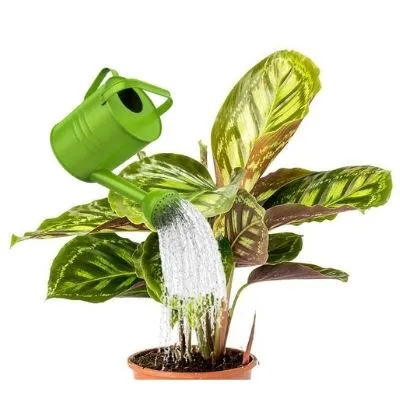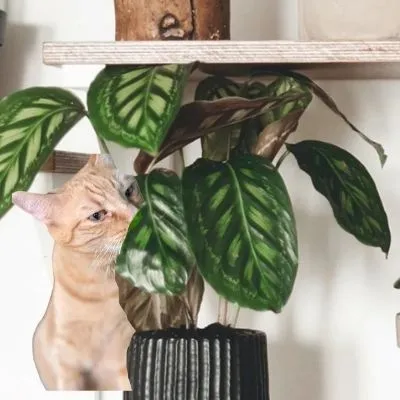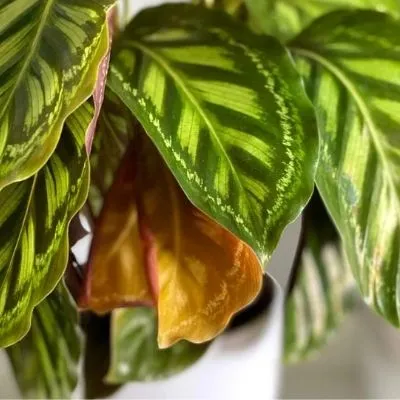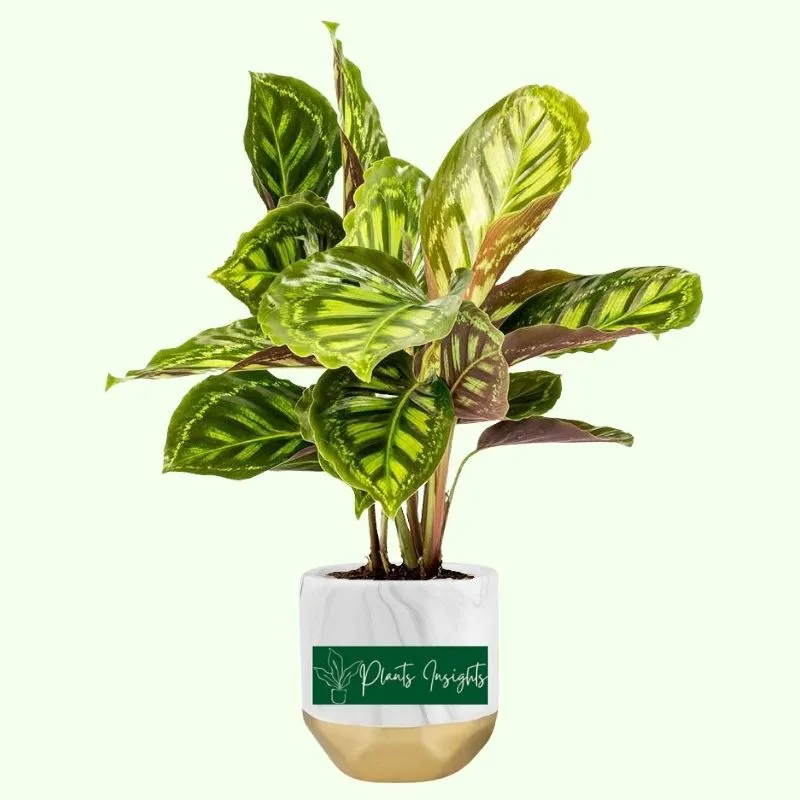The Calathea Flamestar is a fabulous houseplant because of its gorgeous looks and can attract plant lovers to its mesmerizing foliage. The plant possesses stunning patterned leaves with light-colored contrasting pins over dark green mid-span. The leaves have attractive light purple undersides. Like all other Calatheas, the Calathea Flamestar has peculiar requirements to take care of.
Prominent Family Members: Calathea Fasciata, Calathea Leopardina, Calathea Crocata, Calathea Roseopicta, Calathea Picturata, Calathea Lutea, Calathea Freddie
Essential Products:
How do you Care for Calathea Flamestar?
Calathea flame star is native to southeast Brazil, which is warm and humid; accordingly, the Flamestar requires the same conditions to grow and flourish extraordinarily. Furthermore, scheduled watering, moist soil with diffused indirect sunlight, and a humid atmosphere with the perfect required temperature will boost the growth and freshness of the plant.
The Calathea Flamestar allows you to know its needs if something is wrong with the conditions provided. Here is a complete guide on knowing the Calathea Flamestar and how to take care of it.

Adding Flamestar to your Houseplants
Every plant collector is happy to have a new plant in their plant collection, but there is a catch; the plant may be carrying pests or diseases. Flamestar is a bushy plant, and there could be infestation growing under the leaves. So, you must have a close look, particularly at the leaves of the Calathea Flamestar. To be on the safer side, keep the new plant away from all other plants for two weeks to eliminate any chances of the disease spreading to other plants.
You can place the plant with other houseplants in your garden or its desired location when the quarantine time of two weeks is complete. My routine is to spray my new plants with Instant Plant Protection tablets before putting it with other plants and it has saved me the trouble of having pest infestation many times over the years.

Where to Place Your Calathea Flamestar?
Calathea Flamestar grows wildly and dominantly under the shades of Brazilian tropical rainforests tall trees. To give them the same feeling, put them in a place where plenty of indirect sunlight is present or near the north or east-facing window.
Moreover, if the attractive pattern of your plant’s beautiful foliage starts declining or bleaching, direct or too much bright light is the cause of color fading. To recover the plant from the condition, immediately change its spot or provide it with a shade where the plant is exposed to diffused light.

Temperature and Humidity
Calathea Flamestar demands high humidity to flourish, and a minimum of 50% humid air is necessary around the Calathea plant. However, a 60-70% humid atmosphere will be ideal for their growth and health.
If your plant leaves start drooping with brown edges, the Flamestar is in a dry atmosphere. Humidity levels can be increased by using a humidifier or placing the plant in a tray filled with pebbles and water.
Another solution to increase humidity around flame star plants is misting. Spray them with distilled or filtered water frequently, and don’t let mist drops stay on leaves; wipe them off with a clean cloth.
The Temperature requirement of a Calathea Flamestar is quite like a tropical Brazilian forest, which is hot and humid. The indoor temperature of 65 to 74° F is ideal for this plant to thrive.
Try to save them from the hot and cold drafts, as the plant cannot tolerate abrupt temperature variations.

How often should I water my Calathea Flamestar?
Calathea Flame star requires re-watering when the upper two-inch layer of the soil gets dry. Work up your watering routine by checking the soil moisture level. You can check the moisture level by the feeling of the hand or use a soil moisture meter for an accurate result.

Watering Calathea Flamestar
In the growing season from early spring to late summer, usually, the plant requires water two times a week, while in winter, its growth process slows down, and once a week, watering will be enough.
Overwatering will lead the plant to roots rot and yellowing of leaves.
Distilled water or filter water is good when it comes to water type. Calathea Flamestar is sensitive to chemicals, so do not give the tap water as it contains minerals, chlorides, and Fluorides. In addition, rainwater, if available, is best for watering the Flamestar plant.

Soil Mixture for Flamestar
Calathea Flame soil should be moist if you want the plant to flourish dynamically. In addition, the soil must have excellent draining properties to avoid soil becoming soggy.
The plant cannot tolerate dry soil for an extended duration, whereas soggy soil will adversely affect plant growth. Therefore, the soil mix shall perfectly balance moisture-retaining and well-draining constituents.
To make the best soil mix for your Calathea Flamestar, mix one part each of perlite, peat moss, and bark, with three parts of potting soil. Moreover, ready-made soil is also available in stores for specific plants.

Cleaning / Pruning of Flamestar Plant
A clean and soft cloth will do a fantastic job cleaning your plant’s beautiful foliage. To enhance the attractive foliage pattern, wipe the leaves with a wet cloth to remove the dust from glossy leaves.
Pruning is another process to maintain the plant’s shape, size, and beauty by cutting down the sick, damaged, or dead leaves with a sharp scissor, hand Pruner or knife. Please do not forget to sterilize the tools before pruning.

Does Calathea Flamestar need fertilizer?
Yes, they require the extra nutrients during the growing season, fertilize them in spring to late summer every four weeks with nitrogen-based fertilizers.
Please ensure to make a dilute solution according to the packet instructions; also, water your Flamestar plant before applying fertilizer.
Please take extra care during fertilization because overfertilization can be a problem and may result in browning of the leaves and the downfall in plant’s health.

Repotting Calathea Flamestar
Repotting is necessary to provide more space to plant roots required for the plant’s growth. Calathea Flamestar is a moderately fast-growing plant and reaches 40-60cm. After two years, the plant requires repotting or when roots start coming out of the drainage hole or emerging from the topsoil.
Always plan to repot the Calathea Flamestar in spring before the growing season. Please choose one or two sizes bigger pots than the previous one while repotting.
Follow these few steps to repot your Flamestar plant.

Calathea Flamestar Propagation
Propagation is a process by which you can make a baby sapling from a mother plant. Calathea Flamestar can be successfully propagated by dividing its roots.
It’s a simple process and is best to propagate your plant while you are repotting it, as the roots are already out of the pot.
Bring out the plant from the pot and scrutinize the roots. Gently untangle the roots and cut a root section up to the stem with a few leaves with a sharp knife. Plant the cutting a new pot and place it in a dark and humid place until new growth appears.
Additionally, you can make several baby plants from a single mother depending on the number of stems in the mother plant. The bigger the mother plant, the more saplings can be made.

Is Calathea flame star nontoxic for pets?
Calathea Flamestar is not harmful or toxic to pets and humans. Furthermore, no case has been reported of sickness due to contact with Calathea Flamestar.

Calathea Flamestar safe for pets
However, please keep in mind ingestion of plant leaves in large numbers can be harmful despite the non-toxic nature of the plant. Therefore, don’t let anyone nibble on the plant, especially kids and pets who can get mischievous.

Calathea Flamestar Diseases and Pests
Diseases
The pests that usually attack Calathea Fasciata are mealy bugs, spider mites, and aphids. Pests develop colonies on the underside of large leaves of the plant. If you notice an attack from the pests, first try to remove the infestation manually. You can clean the top and bottom surfaces of the leaves with a damp cloth. You can also use a 10% solution of rubbing alcohol for wiping leaves. Please ensure to prune and dispose of the highly infected parts of the plant.
To cure the disease, prune the unhealthy roots, wash the pot with antifungal soap, and plant the Flamestar in the new soil mix.
Pests
Spider mites are occasionally found on the lower surface of the leaves and can easily detect by the web they make on leaves and stems. In addition, Fungus gnat, Aphids, and Mealybugs are also pets of Calathes and feed on leaf sap. Pests can easily be removed by applying Neem oil with a soft cloth or washing the leaves with pesticides soap.
Frequently Asked Questions
Why Patterns on leaves are disappearing?
Exposure of plants to bright light or direct sunlight causes fading of leaves pattern or discoloration. Please move your Calathea Flamestar to a spot where medium diffused sunlight is present.
Why is my Calathea Flamestar Leaves turning yellow/ curling?
The yellowing of the leaves is usually a sign of overwatering. Please stop watering the plant immediately and let the upper two-inch soil layer become dry.

Flamestar leaves turning yellow
Curling of leaves occurs when the plant is exposed to high temperatures. Leaves curl to retain moisture by reducing the exposed surface. Place the plant in a cooler place and water it deeply to solve the issue.
Sometimes, leaves may curl if the plant is under stress due to introducing the new environment.
Why my Calathea Flamestar Leaves Drooping/Wilting?
Calathea Flamestar plant requires moist soil to thrive livelily, but if its soil becomes dry, plant leaves will start drooping, and if dryness prolongs, the plant will wilt to death.
Revise your watering frequency and keep the soil moist at all times to solve the issue.
Why are the tips of leaves on my Calathea Flamestar brown and dry?
Calathea requires more than 50 % humidity in its surrounding; if the atmosphere is dry, the tips of the leaves will start turning brown. Place the plant in a group of houseplants to increase humidity in the surroundings or use a plant humidifier to overcome this problem.

